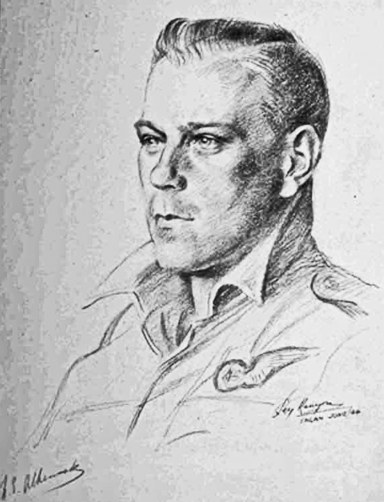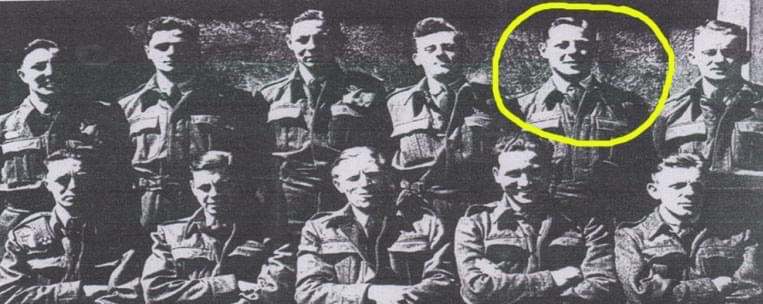 Aircrew Chronicles
Aircrew Chronicles  |
Aircrew Losses
|
Nose Art
|
BCATP
|
Lancaster
|
Media
|
Aircrew Losses
|
Nose Art
|
BCATP
|
Lancaster
|
Media
 Aircrew Chronicles
Aircrew Chronicles  |
Aircrew Losses
|
Nose Art
|
BCATP
|
Lancaster
|
Media
|
Aircrew Losses
|
Nose Art
|
BCATP
|
Lancaster
|
Media
Bomber Command Aircrew Chronicles
Nicholas Stephen Alkemade was born on 10 December 1922 in North Walsham, Norfolk and was a market gardener in Loughborough before the outbreak of war. After training as an Air Gunner, he was posted to 115 Squadron as a rear gunner Lancasters. After successfully completing fourteen operations, Alkemade's crew were detailed to raid Berlin on the night of 24/25 March 1944. One of 811 aircraft destined to attack the German capital, F/S Alkemade's aircraft, DS664, a Lancaster II coded 'A4-K' and christened 'Werewolf' by its crew, took off from RAF Witchford at 18:48 and set course for Berlin. Werewolf carried her seven crew members to Berlin on time and as planned, but the return journey was to be a different story. An unusually strong north wind blew many of the returning aircraft far to the south of their intended track and 'Werewolf' was pushed towards the Ruhr with its heavy concentration of anti-aircraft defences. Shortly before midnight, a Junkers Ju 88 night-fighter flown by Oberleutnant Heinz Rökker of Nachtjagdgeschwader 2, intercepted 'Werewolf' and attacked from beneath with cannon and machine-guns. 'Werewolf's' starboard wing and fuselage were shredded and erupted into flames which streamed back beyond F/S Alkemade's rear turret, the perspex glazing from which had also been completely blown-out, exposing him to the frigid night air. The fight was not totally one-sided, Alkemade managing to get off a burst at the enemy with his four machine-guns, though reports of damage to 'Werewolf's' assailant proved wide of the mark. |

|
The brief combat had mortally wounded 'Werewolf', and before long F/S James Arthur Newman, 'Werewolf's' pilot, ordered the crew to take to their parachutes. A Lancaster's rear turret was too cramped for the gunner to wear a parachute. Instead, it was stored in a canister in the rear fuselage, to be clipped-on to a chest harness when needed.
Centring his turret and opening the doors, Alkemade was greeted by a vision of hell. His parachute was already on fire and the fierce flames seared his exposed face and wrists. His rubber oxygen mask, clamped tight over his mouth and nose, began to melt.
The immense heat forced F/S Alkemade to close the turret doors again. He was trapped, falling through the sky in a burning and abandoned aircraft, 18,000' above enemy territory. And it was about to get worse. The conflagration devouring the aircraft now breached the rear doors and set the turret's hydraulic fluid alight. The liquid-fuelled flames spread to Alkemade's clothing. What could have been going through his mind? I'll let him tell you:
"I had the choice of staying with the aircraft or jumping out. If I stayed, I would be burned to death -my clothes were already well alight and my face and hands burnt, though at the time I scarcely noticed the pain owing to my high state of excitement. I decided to jump and end it all as quick and clean as I could. I rotated the turret to starboard and, not even bothering to take off my helmet and intercom, did a back-flip out into the night. It was very quiet, the only sound being the drumming of aircraft engines in the distance, and no sensation of falling at all. I felt suspended in space. Regrets at not getting home were my chief thoughts, and I did think once that it didn't seem very strange to be going to die in a few seconds -none of the parade of my past or anything else like that."
Falling head-first, looking back towards the stars twinkling in the night sky, F/S Alkemade hurtled towards the ground at 120 mph. At some point in the descent, he lost consciousness, possibly his body's reaction to the pain where the flames had licked around his skin. Above him, 'Werewolf' exploded.
Three hours later, F/S Alkemade opened his eyes. He was lying on snowy ground in a small pine wood. Above him the stars were still visible, only this time they were framed by the edges of the hole he had smashed through the tree canopy. Assessing himself, Alkemade found that he was remarkably intact. In addition to the burns and cuts to the head and thigh, all received in the aircraft, he was suffering only bruising and a twisted knee. Not a single bone had been broken. Both of his flying boots had disappeared, probably torn from his feet as he unconsciously struck the tree branches. Being of no further use, Alkemade discarded his parachute harness in the snow.
Lighting a cigarette from the pack kept in his Irvin suit, F/S Alkemade surveyed his landing zone. The snow was but 18 inches deep and had been sheltered from the sun by the pine trees. Just 20 yards away was open ground completely devoid of snow. If he had come down there, nothing would have saved him. As it was, the flexible branches of the young pines had slowed his descent, just enough for the mattress of snow to cushion him as he reached the ground.
Unable to walk and freezing cold, F/S Alkemade blew his distress whistle to attract attention. A band of German civilians, possibly Home Guardsmen, carried him to a local infirmary which sent him to the better facilities of Meschede Hospital. His burns were tended and a quantity of perspex and wooden splinters were removed from his body.
The next day, F/S Alkemade was interrogated, the Gestapo who demanded to know what had happened to his parachute. When he told them he hadn't used one, the interrogators laughed and accused him of being a spy and burying it. Indignantly Alkemade challenged the Gestapo to find his discarded harness -the lift webs, which would unclip and extend when the parachute deployed, would still be in the stowed position. A search of the wood soon bore out his story. Further corroboration came from the wreckage of 'Werewolf' which had crashed twenty miles away. The metal ripcord handle and cable of his parachute were still in their stowage container.
F/S Alkemade's experience made him into a minor celebrity among the Prisoner of War fraternity. After spending three weeks in hospital, he was sent to the Dulag Luft prisoner of war transit centre. Here the prisoners were paraded and regaled with the incredible tale of Alkemade's survival by a Luftwaffe officer. He was even provided with a commemorative certificate stating:
"It has been investigated and corroborated by the German authorities that the claim of Flight Sergeant Alkemade, No. 1431537, is true in all respects, namely, that he has made a descent from 18,000 feet without a parachute and made a safe landing without injuries, the parachute having been on fire in the aircraft. He landed in deep snow among fir trees."
But what of the rest of 'Werewolf's' crew? Alkemade was just one of seven aboard the Lancaster when Rökke struck. As things transpired, he would be one of only three survivors. Sgt John P. Cleary (Navigator) and Sgt Geoffrey R. Burwell (Wireless Operator) also become prisoners of war after being forcibly ejected from 'Werewolf' by the explosion. Sgt Cleary's damaged parachute self-deployed during his descent into the same wood as Alkemade and he was knocked unconscious in a collision with a tree trunk. Exposed to the crippling cold, Cleary nearly lost a leg to frostbite as well as enduring a collapsed lung. He spent the next six months in Meschede Hospital, before being repatriated as part of an exchange of sick and wounded prisoners in February 1945.
Sadly, the other four crew members of DS664, F/S James Arthur Newman (Pilot), Sgt Edgar William John Warren (Flight Engineer), Sgt Charles Alfred Hilder (Bomb Aimer) and Sgt John Joseph McDonough (Mid-Upper Air Gunner), were all killed. They now lie next to each other in Hannover War Cemetery.
